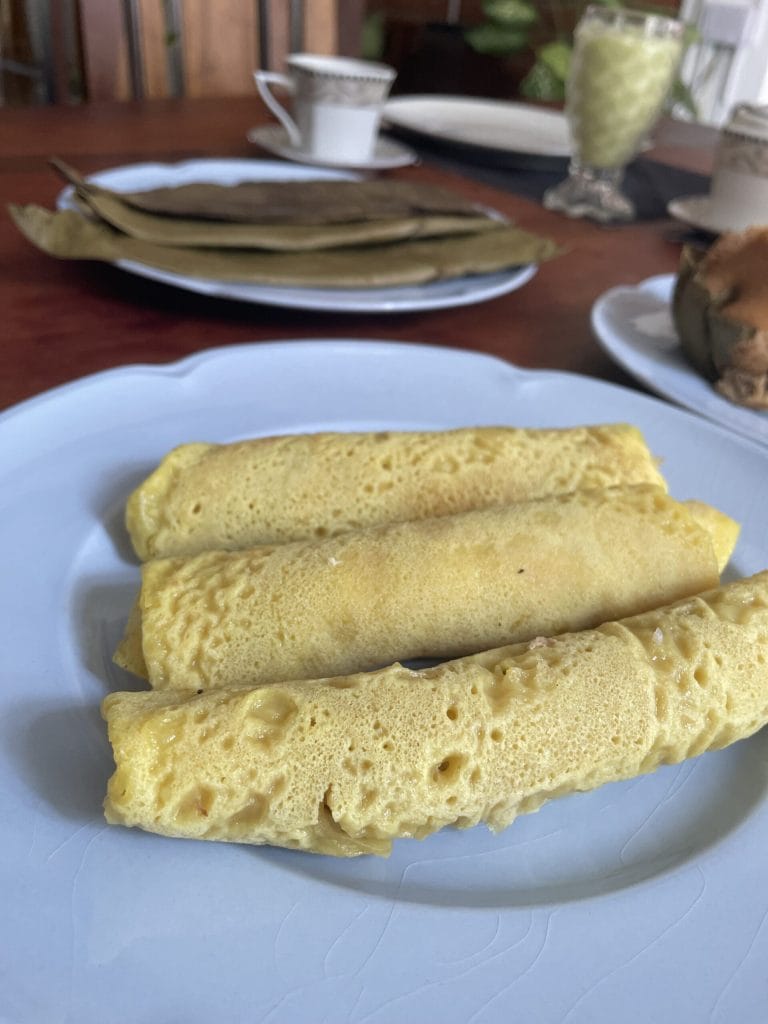Pani pol pancakes, known in Sri Lanka as “Pani Pol Thalapa” or more commonly Sri Lankan coconut pancakes, are thin sweet crêpes, made with a batter of flour, coconut milk, and turmeric (which gives them the yellow color).
Filled with “pani pol”: grated coconut, melted jaggery (or kithul) and spices like cardamom.
Served for breakfast or as a snack.
Very common in Sri Lankan homes and in some guesthouses that serve local dishes; these are the ones tasted at Villa Nivartana during my stay in Bentota in October 2025.

- Difficulty: Easy
- Cost: Economical
- Preparation time: 5 Minutes
- Portions: 8 Pieces
- Cooking methods: Stove
- Cuisine: Sinhalese
- Seasonality: All seasons
Ingredients
- 4.4 oz flour
- 1 cup coconut milk
- 1 egg
- 1/2 teaspoon turmeric
- to taste salt
- chunks coconut oil
- 5.3 oz grated coconut (or shredded)
- 3.5 oz jaggery (grated)
- 3 cardamom (crushed seeds)
Steps
Prepare the filling (Pani Pol):
In a pan, dissolve the jaggery with a little hot water until you get a clear syrup, strain it to remove impurities.
Add grated coconut, cardamom, and a pinch of salt. Cook over low heat until the excess water evaporates and the filling becomes compact but soft.
Let it cool a bit.Prepare the batter:
In a bowl, beat the egg with turmeric and coconut milk.
Add the flour and a pinch of salt, mixing well to avoid lumps.
Add a little water if the batter is too thick (it should be fluid but not watery).Cook:
Lightly grease a non-stick pan and heat it.
Pour a ladle of batter and rotate the pan to distribute it.
Cook on one side only until dry (do not flip).
Repeat until the batter is used up.
Place a generous spoonful of filling in the center of the cooked crêpe.
Roll up like a roll (like a cannelloni).
Traditionally served at room temperature with black tea.

FAQ (Questions and Answers)
Is it correct to refer to all inhabitants of Sri Lanka as Sinhalese even though there are many Tamils?
No, it is not correct to refer to all inhabitants of Sri Lanka as Sinhalese.
Here is the distinction:
Sinhalese
Majority ethnic group in Sri Lanka (about 70–75%).
They speak Sinhalese (Sinhala).
Most are Buddhists.
They mostly inhabit the south, center, and west of the country.
Tamils
They represent about 15% of the population.
They speak Tamil.
Many are Hindus, some are Christians.
They concentrate in the north and east of the island.
Other groups:
Moors (Muslims), Burghers (European descendants), Vedda (indigenous), etc.
✔️ Correct terms:
“Sri Lankan” to refer to all inhabitants of Sri Lanka (neutral and inclusive term).
“Sinhalese” or “Tamil” only if you refer to specific ethnic or linguistic groups.
So:
All Sinhalese are Sri Lankan citizens, but not all Sri Lankans are Sinhalese.What is the difference between pani pol and wellawahum?
Pani Pol and Wellawahum (also known as wellawahuma or wellawahum roti) are two traditional Sri Lankan sweets, often confused because both have a sweet filling of coconut and jaggery.
But there are clear differences:
PANI POL (පැණිපොල්)
Type: Simple sweet, similar to a thin roti or crêpe.
Dough: Based on wheat or rice flour, water, and a pinch of salt.
Filling: Grated coconut + jaggery (panela) + spices (cardamom, cloves).
Cooking: The filling is placed inside the dough disc and then rolled.
Appearance: More simple and homemade, similar to a sweet filled flatbread.
WELLAWAHUM (වෙල්ලවහුම්)
Type: More refined sweet, similar to a rolled pancake.
Dough: More like a pancake or crêpe batter, often with rice flour, coconut milk, and turmeric (for the yellow color).
Filling: The same as pani pol (coconut + jaggery + spices).
Cooking: The crêpe is cooked first on a pan, then stuffed and rolled.
Appearance: Soft, yellow, and fluffier. Often served during festivals or special occasions.

